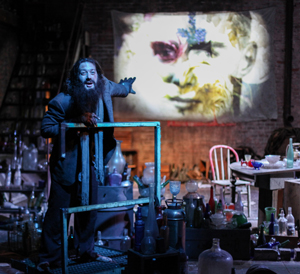
Whether you've seen The Glass Menagerie a hundred times before or only in the textbook, you are unprepared for the spectacle that greets you in this production. First you notice the glass—a dazzling array of bottles, decanters, urns, flasks and goblets, stacked on the stairs, lined up against the walls, assembled in delicately-balanced towers—in short, everywhere you look. Closer scrutiny of this walk-in collage, with its gritty splendor and infectious enchantment, reveals the squalor of an abandoned basement, however—faded advertising murals peeling off raw concrete surfaces coated in grime and urban detritus. Soon a vagrant appears, his purpose to recount to us—after promising to deliver "truth in the pleasant disguise of an illusion"—the story of a family he left behind long ago.
Locating Tennessee Williams' self-defined "memory play" within its hero's none-too-lucid consciousness is the innovative idea of director Hans Fleischmann, who also portrays Tom Wingfield, the derelict narrator whose guilt over abandoning his mother and sister manifests itself in a persistent vision of the latter's treasured glass figurines. "Tom's refuge should look like Superman's Fortress of Solitude." he recalls telling Grant Sabin and Arianna Soloway—respectively, his scenic and property designers, "I wanted hundreds of pieces, even thousands! I don't think anybody really understood what this was about until we started sculpting it the week before we opened at Angel Island."
Constructing a palace out of curbside crystal isn't a task to be undertaken alone. "A small army" was dispatched in search of materials, including Fleischmann's and Sabin's mothers, whose mission was to scour antique shops for tall vases and chandelier globes. Discarded bottles were scavenged from several bars—Soloway even admits to "scooping up empties after parties"—as thrift stores and garage sales over several counties were ransacked for the curious trinkets making up Laura Wingfield's fragile fantasy-kingdom. "It took a village to bring this set to life!" declares Sabin.
The glass is not piled on the stage at random, but arranged with all the care and precision of a Cornell box. "Tom has used the alley debris to recreate the rooms of his former home," Sabin explains, with Soloway adding, "His corner in the back is furnished almost entirely in plain, dark-colored bottles, while Laura's 'menagerie' downstage is composed of the most beautiful pieces." The surfaces were then sprayed with tan paint, not only to reduce the reflection, but also to give them a dirty, discolored appearance. ("With clean glass, you run the risk of the stage looking like a bar.")
Placing bottles on the high beams and fire escape—none of them weight-bearing—from precarious perches atop ladders was the most difficult part of creating the dramatic environment, according to Sabin, but performing on a floor littered with razor-edged fragments is not without its hazards, too. In his role as Tom, Fleischmann is barefoot throughout the play, "During the first run, I ended up with a lot of glass in my feet," he reports, "I've been luckier in the new quarters at Theater Wit."
The Glass Menagerie runs at Theater Wit through July 28.
Mary Shen Barnidge
Contributing Writer

 Follow Us On Twitter
Follow Us On Twitter